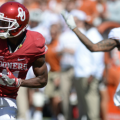For a unit that makes up over 45 percent of a formation on any given snap, a team’s offensive line doesn’t get nearly enough credit towards an offense’s success as they deserve. The world has begun to come around to the idea that offensive lines and schemes can make or break running backs – but what about quarterbacks?
A running back’s average yards before and after contact serves as a decent indicator of their success independent of their team’s offensive line. The same can’t be said for quarterbacks. While average depth of target and average time to throw are partially driven by offensive line play, both of those stats are also based on the quarterback’s scheme and ability.
Evaluating the ability of five offensive linemen combining to form a whole isn’t an easy task, but luckily heroes around the fantasy industry have done just that – and they appear to be on the same page. The correlation coefficient between offensive line rankings from Pro Football Focus and PlayerProfiler was an incredible .84 in 2014, and they’ve remained strongly positively correlated ever since.
In addition to subjective unit rankings, Football Outsiders charts each team’s adjusted sack rate, which represents sacks (plus intentional grounding penalties) per pass attempt adjusted for down, distance, and opponent.
There are pros and cons to valuing subjective reviews over objective reviews, and PFF and PlayerProfiler obviously consulted plenty of data in developing their rankings. Let’s take a look at how quarterbacks with the best- and worst-ranked offensive lines from both the experts and the data have performed since 2014.
Overall Performance from Quarterbacks with Top- and Bottom-10 Offensive Lines

The above information is courtesy of our Trends tool. The top- and bottom-10 rank groups represent the average production of PFF and PlayerProfiler’s top- and bottom-10 offensive lines from 2014 to 2016. The top- and bottom-10 DVOA groups represent the top- and bottom-10 offensive lines in adjusted sack rate from 2014 to 2016. Each group had a decent amount of carryover from year to year, as at least nine teams made multiple appearances for all four groups.
The general three-year results make sense: Quarterbacks with good offensive lines have been better than quarterbacks with bad offensive lines. Interestingly, the disparity is much greater between the rank groups than it is between the DVOA groups. Now we’ll check the production from these four groups when playing at home:

Quarterbacks with top-10 offensive lines have absolutely balled out at home. Quarterbacks with bottom-10 offensive lines have essentially produced their average stat line at home. While there has been heightened ownership for the quarterbacks with an elite offensive line, the double-digit Consistency Rating differentials are more than enough to make up for an ownership premium. Pro subscribers can access our DFS Ownership Dashboard shortly after lock to monitor the ownership of quarterbacks with great offensive lines at home.
The idea that quarterbacks, and offenses in general, thrive more at home behind solid offensive lines matches what we’d expect. Crowd noise, an unfamiliar stadium, and well-rested defensive linemen await offensive lines at every road game. Placing a dominant five-man group built on cohesiveness and communication in a better-suited environment for their offense to thrive has unsurprisingly led to enhanced production from the quarterback.
The slip in production from quarterbacks with good offensive lines on the road reinforces this point:

All quarterbacks have struggled on the road, but the differential between our DVOA groups is especially surprising. Quarterbacks with a bottom-10 adjusted sack rate have been the most consistent group on the road – with an ownership discount!
Quarterbacks with poor offensive lines don’t magically play better on the road, but this combination could inevitably lead to more DFS-friendly game scripts for the passing game. Since 2014, quarterbacks with a win percentage under 40 percent have been more consistent on the road than quarterbacks with a win percentage above 60 percent. This phenomenon helps explains why Blake Bortles has been a relevant DFS quarterback over the past three seasons. But again, untangling line play from other factors on a quarterback’s production is difficult, and we could be experiencing some noise here, too.
As it turns out, the same DVOA group also posted a solid Consistency Rating as underdogs (you can monitor up-to-the-minute Vegas lines using our Vegas dashboard):

Remember to also evaluate the group average for the above charts. Quarterbacks with a bottom-10 DVOA group may comparatively perform better than the other groups on the road and as underdogs in certain metrics, but all of those quarterbacks have been fairly poor options overall.
Quarterbacks with top-10 offensive lines have thrived at home and as favorites:

This production has come with an ownership premium, but it’s hard to complain too much about a group with a +3.41 Plus/Minus on DraftKings and +2.32 on FanDuel since 2014. When building stacks with our Lineup Builder, or evaluating slates with our NFL Models, consider targeting quarterbacks with an offensive line capable of dominating a cushy home matchup or clearly inferior opponent.
Takeaways
In general, quarterbacks with strong offensive lines have outperformed those with poor offensive lines – especially at home and as favorites. This has been the case when considering top offensive lines based on rankings from analysts, as well as through the use of adjusted sack rate.
Quarterbacks with poor offensive lines have posted more agnostic home/away splits than those with great offensive lines. One idea to explain this is that bad teams generally get favorable passing game scripts in road matchups. Quarterbacks with great offensive lines haven’t been as effective on the road, perhaps due to those quarterbacks being more dependent on their elite offensive line than others.
Offensive linemen may not be the most fun position group to evaluate, but they’re still vitally important. When evaluating DFS quarterbacks, be sure to monitor hurry stats on our Matchups page, as well as our industry-leading and DFS-focused News blurbs to identify the league’s best and worst offensive lines.





